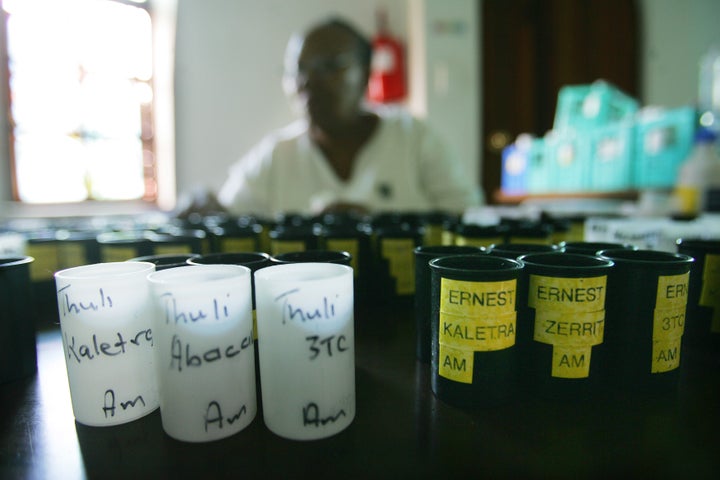
What comes to your mind when you hear the words "AIDS orphans"? Do you imagine a skinny, destitute African child with matchstick legs? Is he or she young -- maybe 7- or 8-years-old? Are there flies in the child's eyes? What do you think would be the best way to help this child? Should you send money to an orphanage that can provide food, shelter, clothing, and education? How about a mission trip to bring soccer balls and medicine? What about international adoption as an option?
Popular American conceptions about so-called "AIDS orphans" are based largely on well-intentioned but ultimately inaccurate portrayals about who children affected by HIV and AIDS really are. We are also misguided about how best to help them. A recent Grey's Anatomy plotline saw the character Karev fly a bunch of thickly accented "Africans" (no country specified) to Seattle for advanced surgeries in a ploy that would help him become chief resident at Mercy West. (It didn't work out for him.) Madonna notoriously chose her first adopted child out of a line-up at an "orphanage" in Malawi, only to learn later that his father was still alive. (In an open letter, she claimed to want to "help one child escape an extreme life of hardship, poverty and in many cases death.")
For starters, kindly banish the phrase "AIDS orphans" from your vocabulary. This nomenclature has been taboo among actors working on child welfare and on HIV and AIDS for years -- and for good reasons. Children identified as "AIDS orphans" are immediately labeled and stigmatized, branded within their communities and further associated with a disease that has already deprived them of so much. Moreover, although the number of children who have lost one or both parents to AIDS is staggering -- 16.6 million worldwide (and 14.9 million of those in Africa) -- a number of studies have concluded that being an orphan is only one factor among many that influence children's well-being. As with any other children, those affected by HIV and AIDS are also affected by their sex, socio-economic status, level of education, and any number of other factors. A child affected by HIV and AIDS might be an upper-class high school kid in Cape Town, living with his mother because he lost his father to the disease years ago. He may be a young adolescent living on the streets of Odessa, forced to engage in sex work to make ends meet and taking up drugs to cope with harsh realities. She may be a young girl in rural Mozambique or Zimbabwe, leading a quiet existence with her grandmother ever since she can remember, enjoying school.
If we recognize that children affected by HIV and AIDS are leading multi-faceted and complicated lives, we must also realize that the efforts we bring to bear on their behalf should be nuanced, sophisticated, and well planned. A conference convened last week by UNICEF brought together global activists, scholars, policymakers, government workers, and non-profit organization representatives to take stock of what we know about these children and how best to help them. What UNICEF and others are learning might surprise you.
The first place that many people start their thinking -- that is, orphanages -- should actually come in last place as study after study have shown that placing children in institutional settings puts them at great risk. If orphanages have rightfully become obsolete in the United States, why should we be promoting them in less developed countries?
Naturally, we shouldn't. Indeed, humanitarian agencies now agree on an approach to support children affected by HIV and AIDS that focuses on families and communities. As Martin Mogwanja, the Deputy Director of UNICEF and a native of Kenya, pointed out, "the HIV and AIDS pandemic has highlighted the extraordinary resilience of the extended African family" as aunts, uncles, grandmothers, and others have come together to support children who have lost parents to the disease. Activities to support and strengthen these extended families are now the centerpiece of a wide array of programs designed to improve the protection and care of children affected by HIV and AIDS. The variety of ways to support families and communities to better care for vulnerable children is mind-boggling.
Cash transfers, commonly called "social protection" in international discussions, are showing promising results as a method of helping families to cope with life's difficulties. (After all, cash transfers have long formed part of the American welfare system, so it seems almost strange that it has taken them so long to catch on in international development.) This fact is especially true when cash transfers are coupled with other training and support initiatives. A recent World Bank study in Malawi of a program that linked cash transfers to girls' school attendance found a 60% reduction decrease in the girls' risk of contracting HIV and other sexually transmitted infections after the first 18 months of the program. There was also evidence that participants in the program were three to four times more likely to be in school and more likely to delay marriage and pregnancy.
Efforts for children affected by HIV and AIDS also need to be age- and gender-appropriate. Policymakers are increasingly recognizing the need to focus on early childhood education for children under the age of five, an age group that has been relatively underserved in the fight against HIV and AIDS. And with the HIV and AIDS pandemic now in its thirtieth year, we must think about children who are transitioning to adulthood. Innovative programs in Botswana are working with adolescents and young adults living with HIV, tackling delicate questions about when and how to reveal their HIV status to them, ensure treatment adherence as they take increasing responsibility, and accompany them into full and healthy adult lives. Concerted efforts are underway to address the sexual and gender-based violence that pose a constant threat to women and girls in many places.
In this long-term struggle, many African families -- especially in eastern and southern African countries -- have been stretched to the limit, and the efforts described above have until now remained mostly small-scale and relatively isolated endeavors. Perhaps the greatest step forward in assisting children affected by HIV and AIDS is increased international awareness of the need to help other governments to strengthen their national welfare systems. Much of the work to-date has relied heavily on volunteers, and new emphasis is being placed on helping other countries to train and employ social workers to help families and communities to cope with the crisis.
The United States government has spent approximately $1 billion since 2003 on programs to provide protection, care, and support to children affected by HIV and AIDS, a staggering amount by any measure. While programs have become increasingly sophisticated and effective, the path forward is a long one: after all, only 11% of households worldwide with children affected by HIV and AIDS receive any external support at all. But the next time you are thinking of taking a mission trip to visit "AIDS orphans" in Africa, don't pull a Madonna and try to rescue anyone. I hope that you will pause, remind yourself not to use the phrase "AIDS orphans" anymore, and take the time to examine some of the vast technical resources that are available to anyone who is interested. There are far better ways for you to invest your time, money, and compassion.
